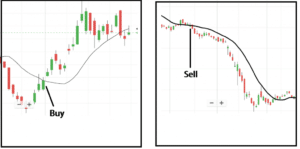The foreign exchange market, or forex for short, is a dynamic beast. Traders constantly grapple with deciphering price movements and underlying market sentiment. In this quest, technical indicators serve as valuable tools, offering insights beyond just price action. One such indicator, the Market Thrust Indicator (MTI), deserves a closer look for its unique ability to gauge market strength.
Decoding the Market Thrust Indicator
At its core, the MTI is a momentum oscillator specifically designed for stock markets. However, its principles can be applied to forex with some adjustments. It analyzes the internal strength of the market by considering two key aspects:
- Number of Advancing/Declining Issues: This refers to the number of stocks or currency pairs that are rising (advancing) or falling (declining) within a specific timeframe. In the context of forex, it translates to the number of currency pairs experiencing positive or negative price movements.
- Volume Associated with These Movements: Simply counting advancing or declining issues isn’t enough. The MTI factors in the trading volume behind these movements. A strong advance with high volume carries more weight than a weak advance with low volume.
By combining these elements, the MTI essentially calculates the difference between the buying pressure (advancing issues * advancing volume) and the selling pressure (declining issues * declining volume). This difference reflects the overall market thrust, indicating whether buyers or sellers are in control.
Interpreting the MTI for Forex Trading
The MTI is typically displayed as a line with a zero line acting as the central axis. Positive values represent a market dominated by buying pressure, while negative values indicate selling pressure. Here’s a breakdown of how to interpret the MTI for forex trading:
- Positive MTI: A rising MTI suggests increasing buying pressure in the market. This could signal potential price advances, especially if supported by other technical indicators like rising price channels.
- Negative MTI: A falling MTI indicates increasing selling pressure, potentially foreshadowing price declines. However, be cautious of false signals, particularly during strong consolidation phases.
- Zero Line: The zero line represents a balance between buying and selling pressure. It doesn’t necessarily predict a trend change, but extended periods around zero might indicate indecision or range-bound markets.
Beyond Basic Interpretation:
While the basic interpretation provides a good starting point, forex traders can delve deeper to extract more nuanced signals from the MTI:
- Rate of Change: The speed at which the MTI moves can be crucial. A sharp rise in the MTI suggests a strong directional move, while a gradual rise might indicate a more sustainable uptrend.
- Divergence: When the MTI diverges from the price action, it can signal a potential trend reversal. For instance, a rising price with a falling MTI suggests weakening buying pressure, potentially foreshadowing a price decline.
- Confirmation with Other Indicators: The MTI is most effective when used in conjunction with other technical indicators like relative strength index (RSI) or moving averages. Combining these tools can provide a more robust trading signal.
Limitations of the Market Thrust Indicator
It’s important to acknowledge that the MTI, like any other technical indicator, has limitations:
- Market Specificity: The MTI was originally designed for stock markets, and its application to forex requires some adaptation. The number of currency pairs is significantly lower compared to stocks, potentially impacting the MTI’s sensitivity.
- False Signals: The MTI can generate false signals, especially during periods of high volatility or consolidation. Combining it with other indicators and fundamental analysis helps mitigate this risk.
- Delayed Confirmation: The MTI reacts to market activity with a slight lag. This means it might not capture the very beginning of a trend, but rather confirm its continuation.
Leveraging the Market Thrust Indicator in Your Forex Trading Strategy
Here’s how you can integrate the MTI into your forex trading strategy:
- Identify Potential Trends: Use the MTI to gauge the overall market sentiment and identify potential trend directions. A rising MTI with confirmation from other indicators can suggest a buying opportunity, while a falling MTI might signal a potential shorting opportunity.
- Confirm Trend Strength: The rate of change of the MTI can help assess the strength of a trend. A sharp rise or fall suggests a strong directional move, while a gradual change might indicate a more sustainable trend.
- Identify Divergences: Watch for divergences between the MTI and price action. A divergence can signal a potential trend reversal, prompting you to re-evaluate your trading position.
- Risk Management: Remember, the MTI is just one piece of the puzzle. Always employ proper risk management techniques like stop-loss orders to limit potential losses, regardless of the MTI’s signal.
The Market Thrust Indicator, while not without limitations, offers valuable insights into the internal strength of the forex market. By understanding its core principles, interpretation techniques, and limitations, you can leverage the MTI to:
- Refine your market sentiment analysis: The MTI goes beyond just price action, providing a glimpse into the underlying buying and selling pressures.
- Enhance your technical analysis toolkit: The MTI complements other technical indicators, offering a more comprehensive view of potential trends and divergences.
- Develop a more informed trading strategy: By incorporating the MTI’s signals into your trading strategy, you can make more calculated decisions based on market momentum.
However, remember that the MTI is just one tool in your forex trading arsenal. Always consider:
- Fundamental analysis: Stay informed about economic data releases, central bank policies, and geopolitical events that can significantly impact forex markets.
- Risk management: Implement proper risk management practices like stop-loss orders and position sizing to mitigate potential losses.
- Backtesting and Paper Trading: Before deploying the MTI in live trading, backtest its performance on historical data and practice using it with a paper trading account.
By combining the MTI with other technical and fundamental analysis tools, you can develop a more comprehensive understanding of the forex market and make informed trading decisions that align with your risk tolerance and trading goals.
Let’s Manage Your Forex Funds With Fx Pips Guru!
Fx Pips Guru is a forex fund management company managing client’s funds based on monthly profit share. Let’s do Live Chat with our experts.




